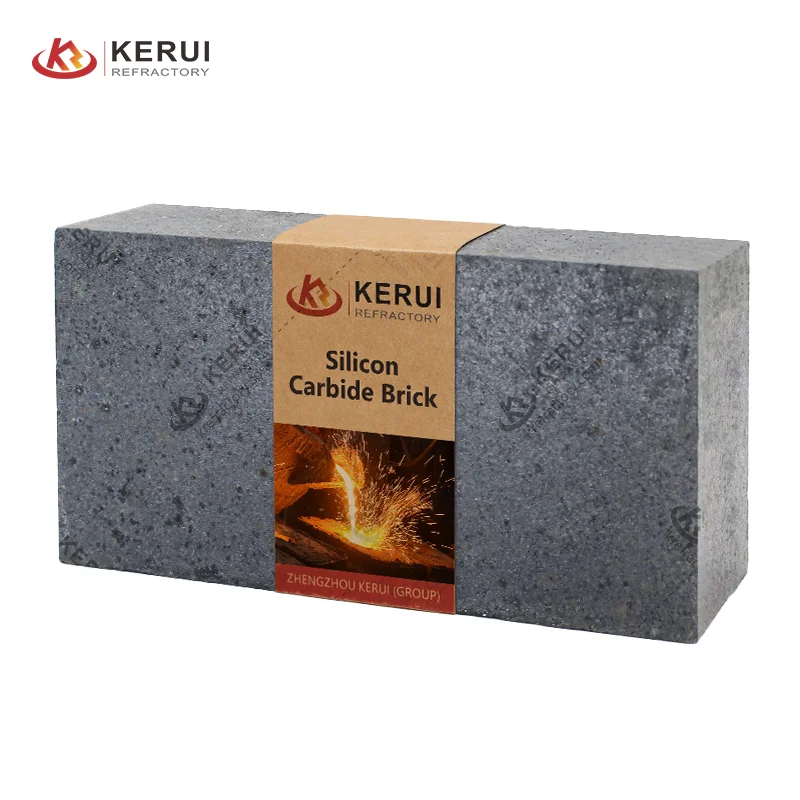Article Navigation
- Overview & Key Advantages
- Technical Specifications
- Industrial Applications
- Procurement & Cost Analysis
- Why Choose Kerui?
1. Overview & Key Advantages
Silicon Carbide refractory bricks (SiC) are ultra-durable materials engineered for extreme thermal, mechanical, and chemical challenges. With thermal stability up to 1,800°C (3,272°F) and unmatched abrasion resistance, they outperform traditional alumina and fireclay bricks in harsh environments. Kerui Refractory’s SiC bricks, produced under ISO 9001-certified processes, deliver:
- Extended Lifespan: 3–5x longer service life than standard bricks in high-abrasion zones.
- Energy Efficiency: High thermal conductivity (15–25 W/m·K) enables rapid heat transfer.
- Corrosion Resistance: Immune to acidic/alkaline slags and molten metals.



2. Technical Specifications
2.1 Material Grades & Performance
| Grade | SiC Content | Max Temp | CCS | Porosity | Thermal Shock Resistance |
|---|---|---|---|---|---|
| Clay-Bonded SiC | 50–70% | 1,450°C | 60–100 MPa | 15–20% | >15 cycles (1,100°C ΔT) |
| Nitride-Bonded SiC | 85–90% | 1,650°C | 120–180 MPa | 12–15% | >30 cycles |
| Recrystallized SiC | ≥99% | 1,800°C | 80–120 MPa | 10–12% | >50 cycles |
Kerui’s KR-SiC90 Nitride-Bonded SiC Bricks achieve 1,700°C stability with <14% porosity and 160 MPa CCS.
2.2 Comparative Advantages
- Abrasion Resistance: 3x higher than high-alumina bricks in cement kiln transition zones.
- Oxidation Resistance: Protective SiO₂ layer forms at 1,200°C+, enhancing longevity.
3. Industrial Applications
3.1 Metallurgy
- Blast Furnace Tuyeres: Withstand 1,600°C+ hot airflow and iron splashes.
- Aluminum Smelters: Resistant to molten aluminum penetration (low wettability).
3.2 Energy & Chemicals
- Biomass Boilers: Combat ash abrasion and alkali corrosion.
- Petrochemical Reactors: Ideal for sulfur-rich and hydrogen atmospheres.
3.3 Ceramics & Cement
- Kiln Furniture: SiC setters and saggers for high-purity ceramic firing.
- Clinker Coolers: Durable linings for abrasive clinker particles.
4. Procurement & Cost Analysis
4.1 Pricing & MOQs
Silicon Carbide refractory bricks for sales
| Grade | Price Range (FOB) | Min Order Quantity | Bulk Discounts (>15 tons) |
|---|---|---|---|
| Clay-Bonded SiC | $500–900/ton | 1 tons | 5–10% |
| Nitride-Bonded SiC | $700–1200/ton | 1 ton | 8–12% |
| Recrystallized SiC | $1000–1500/ton | 0.5 tons | 10–15% |
4.2 Supplier Selection Checklist
- ✅ Certifications: ISO 9001, ASTM C863 compliance.
- ✅ Customization: Ability to produce non-standard shapes (e.g., arches, nozzles).
- ✅ Testing Reports: Demand third-party CCS, porosity, and thermal shock data.
4.3 Installation Best Practices
- Mortar Compatibility: Use SiC-based refractory mortar for joints ≤2mm.
- Thermal Cycling: Limit heating/cooling rates to ≤100°C/hour.
5. Why Choose Kerui?
5.1 Advanced Manufacturing
- Proprietary Bonding Tech: Kerui’s nitride-bonded SiC bricks feature Si₃N₄/Si₂ON₂ matrices for 30% higher oxidation resistance.
- Quality Control: Silicon Carbide refractory bricks laser particle size analysis ensures batch consistency (±2% SiC content).
5.2 Global Support Network
- Fast Delivery: 80% of orders ship within 15 days, even for custom geometries.
- Technical Consultations: Free kiln lining design audits to optimize brick selection.
5.3 Success Story
A Chinese cement plant using Kerui’s Silicon Carbide refractory bricks in a 5,000 TPD kiln preheater reported:
- 40% reduction in annual maintenance costs.
- Lining lifespan extended from 8 to 22 months.
Conclusion
Silicon carbide refractory bricks are indispensable for industries demanding extreme durability and thermal efficiency. Kerui Refractory—a leader in advanced ceramic solutions—combines 15+ years of R&D expertise with cost-effective production to deliver SiC bricks that excel in abrasion, corrosion, and thermal shock resistance.
Take Action Today:
- 📩 Request a custom quote for your project.
- 📞 Contact +86-153 7871 8880 for sample requests or technical support.
Performance data based on ASTM standards and Kerui’s internal testing. Results may vary by operational conditions.





